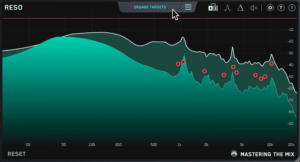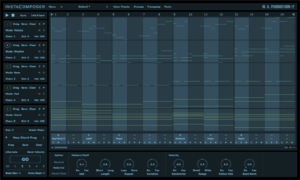

What is Harmonic Mixing?
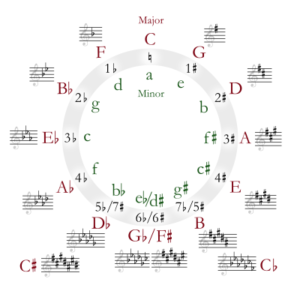
Harmonic mixing, or key mixing, is when a DJ blends between 2 tracks that share the same key or a related key. This harmonic mix means the two songs share a similar scale of notes. Thus giving the mix a very smooth, harmonic and great sounding transition.
Many good DJs do this purely by ear. Have you ever listened to two different songs and just known they would work well together? That’s probably because you’ve recognised the two songs are in the same key without consciously thinking about it.
Music theory can be daunting, but don’t let that put you off learning more about harmonic mixing. With the information and the tools suggested below, it will be easy for you to gain a better understanding of the topic.
I also think it’s good for music producers to have an understanding of this. Some of the techniques can be applied to your projects and understanding how keys work with each other will greatly help you with your productions.
How Does Harmonic Mixing Work?
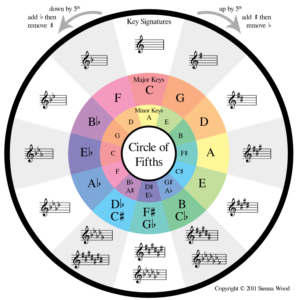
Harmonic mixing works when the scale of each song (key) shares many or all of the same notes. This means the transition has a great chance of being smooth and sounding ‘in key’ to the listeners, avoiding nasty clashing, out of pitch notes.
Knowing the key of your songs is very important to this, and there are a variety of tools to help you work out the key of a song. You don’t need to learn what the notes are in each scale, using the circle of fifths as a visual reference and some clever meta labels, you can easily organise your music for on-the-go harmonic mixing.
Each key is made up of a scale of notes. A scale is any set of musical notes ordered by fundamental frequency or pitch. There are many different scales out there but the most common we use in western dance music are the Major and Minor scales.
Each ‘Major’ key has a relative ‘Minor’ key that will have the same notes but with a different ‘root’ note (to keep it simple that’s the first note in the scale).
How To Harmonic Mix with the circle of fifths
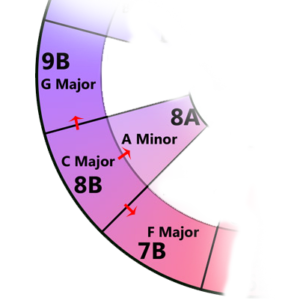
Harmonic mixing can be easily visualised with the circle of fifths. This is a great visual aid that organises the 12 chromatic pitches as a sequence of perfect fifths. This generally means an arrangement of the minor and major scales around a circle. The order is based on the notes in the scales. This allows us to quickly see which keys are relative to each other.
Using the circle of fifths we can label our music correctly and mix between songs knowing that they will most likely sound good, without any clashing pitches. However, having to check an image every time you want to know which key to mix into next isn’t ideal. That’s why we use custom key codes instead of the original musical ones. We can also use tools to make this process simpler.
The most common set of codes use the numbers 1 to 12 for each root note, and two different letters for minor/major keys. Two of the most popular sets are Open Code Notation and the Camelot Wheel Notation popularised by the Mixed In Key software.
Camelot Notation uses numbers 1-12 and the letter A for minor keys, and the letter B for major keys. Open Code also uses numbers 1-12, but letter m for minor keys, and the letter d for major keys Once your music is labelled correctly with this custom code you will no longer need to reference the circle of fifths.

On top are the notes of the C major scale. Below are the notes of the A minor scale. The lines connect the notes that are the same in both scales. You can see that the only difference is the order of the notes. This is why A minor is a relative key of C major, and how we know the two scales will mix harmonically.
For example:
The key of C major and the key of A minor share the same notes in their scale. This means songs in these keys would mix harmonically. Using the Camelot wheel key codes, C major is represented by 8B and A minor by 8A.
We know that songs with the code 8B can be harmonically mixed with songs with the codes; 8B, 8A, 7B or 9B.
To sum up, the number can go up or down by 1 but the letter must stay the same. OR… The letter can change but the number must remain the same. This is the most basic way to use the circle of fifths.
This is just a simple example of how harmonic mixing is easily done without needing any in-depth knowledge of music theory. All you need to do is add the key codes to your songs meta information, and often this can be done for you by a variety of software.
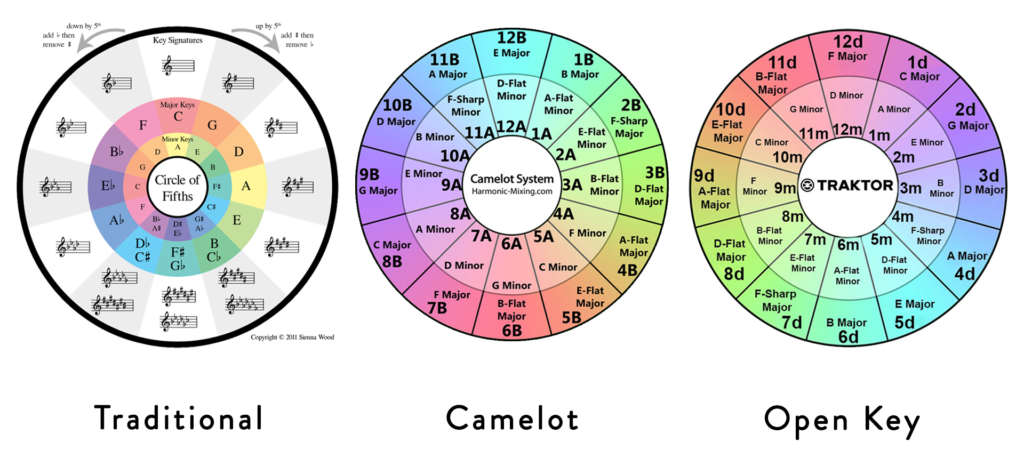
What tools are helpful for harmonic mixing?
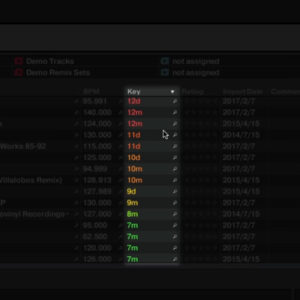
There are more tools than ever before to help your harmonic mixing. You’ll find that most Djing software has some sort of key reading tool built-in. If not there’s software like Mixed In Key or the free but old, Keyfinder. Tools like this analyse your mp3 library, detect which key the songs are in, and then automatically add the key codes to the metadata of the song.
Once correctly labelled, you can then easily sort your music in your DJing software or setup, and effortlessly mix harmonically.
Most modern DJ software has built-in key detection. Traktor by Native Instruments automatically detects the key of your song when it first analyses the track. This can also be done manually. When viewing your music library in Traktor there will be a column displaying the key of each song. You might have to make it visible by right-clicking the header bar above the songs.
Serato also does a similar process, automatically analysing your files and adding the relevant data.
If you have no key detection tools already there is a very comprehensive tool called Mixed In Key. Alternatively, there’s a free plugin called Keyfinder that performs well. Unfortunately, it is not really updated anymore.
The information is added to your mp3 using ID3 tags. This means that once the information has been added by one program, it can be read by all the other ones too. This means changing your DJing software or taking your music to another setup won’t lose the key information stored with the song, just like the BPM and other information.
Why is Harmonic Mixing helpful for Music Producers?
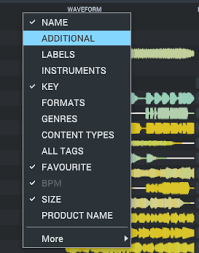
Understanding harmonic mixing can help music producers make better songs. For many years a certain technique has been used by many professional producers to make their songs jump up (or down) in energy. This is achieved by understanding the circle of fifths.
Although you might not use the custom codes as much in music production it’s very useful to have a basic understanding of musical scales, key and harmonic mixing. Have you ever worked with samples that are both labelled as ‘E’ but seem to clash? The chances are one is in the key of E minor and the other, the key of E major.
You might like to label your sample library with better tags or with custom code notation but to be honest, I wouldn’t recommend it. Before sample library plugins like Loopcloud came along, this is something I would do. I would use tools to analyse my samples and then organise them into folders organised by instrument and key.
Thankfully, it’s a lot more common for this information to be found within the samples already or are easily found as searchable tags in plugins like Loopcloud by Loopmasters. What I would recommend is keeping a picture of the circle of fifths handy.
Normally you would make a song in one key. However, understanding how scales relate to each other can open up new musical opportunities. A technique that’s been used in music for many years is to use a key change to alter the mood or feel of the song. This can be a great way of making a song suddenly have a lot more energy than before. Or make the music take a more moody tone.
Knowing which key to change to can be worked out using the circle of fifths just the same as if we were Djing. So if I was making a song in C major but I wanted the second half to break into a less ‘happy’ and ‘darker’ sound then I might use a key change into the relative minor. Looking at the circle of fifths I know that the relative minor of C major is A minor.
This is a simple example. In music production, you are more likely to use the advanced harmonic mixing method below to create a better and more impactful effect.
What is a more advanced way to use harmonic mixing
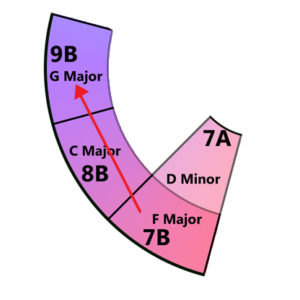
Harmonic mixing by simply changing from minor to major or by just one step is a very basic way of doing things. The circle of fifths opens up the potential for more advanced harmonic mixing techniques.
One of my favourites is this great way of really making your mix increase (or decrease) in energy by making a bigger key change. To give your mix an energy boost like this you need to do the following:
Instead of moving up by +1 (e.g. 8A – 9A) move up 2 steps instead (e.g. 8A – 10A). Ok, that’s still really simple. However, using this technique takes a bit more experience. It’s something you need to use in moderation and at the right times during your set.
By moving that extra step away you’re increasing the number of different notes in the scale. This means the two songs you are mixing are more likely to clash in parts. It’s a good idea to practice this technique with your library of songs and pick the ones it works best with.
It’s also possible to reverse the effect (maybe to wind down the ravers at the end of the night) by dropping by 2 instead of going up (8A – 6A).
A good DJ knows how to read the crowd and when to use these energy-boosting techniques. Playing constant high energy mixes might seem like the right idea for a banging party. The reality is though that the crowd will quickly get tired and the dancefloor will empty.
Another powerful way to change the key is to move 5 steps down instead (8A – 3A). This is another great way to boost the energy of your mixes that again should be used carefully and in moderation.
Harmonic mixing opens up many possibilities and is essential if you want to be great at remixing on the fly and working with modern DJ techniques and formats, STEMS being a great example. Most DJ software allows for multiple songs to be mixed at a time, keeping your music in key will make your mixes sound fantastic and makes on-the-fly mashups an ease to perform.
Most DJ software also gives an energy level to your music. Many top DJs are using energy levels combined with harmonic mixing energy boosts to create highly memorable DJ sets. When using an energy boost make sure the song you are mixing into also has a higher ‘energy’ than the song you are currently in. This will make the effect even more impressive.
Conclusion
Gone are the days that we need to sit there listening to each of our songs whilst playing notes on the piano hoping to guess the key correctly. There are plenty of tools to help, engines to search and built-in functions of almost all DJing software that will make sure your music library is ready for beautiful harmonic mixing. So make the most of it.
One last thing I would like to say though is don’t neglect those ears. Algorithms can make mistakes, and many songs don’t fall into the conventional major/minor keys or may even change key. Nothing will ever beat an actual human ear when it comes to DJing and mixing music. Remember that these key codes should be used as an aid. Keep practising and pay attention to how the songs sound together.
With more practice and experience you will get better and better at recognising which songs will go well together just using your ears. You might even start being able to work out what key a song is in, but that is of course, very hard.


